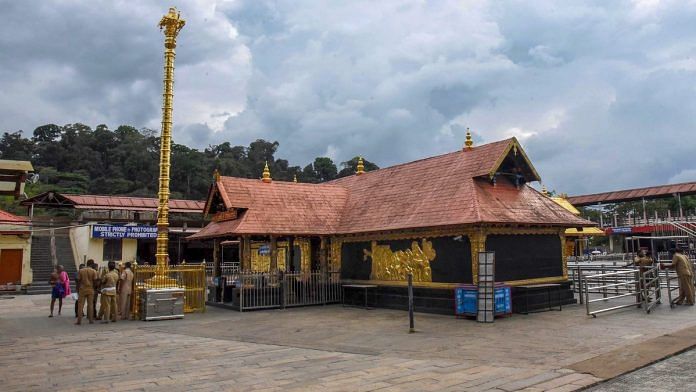On Sabarimala, all political parties have taken positions like deft chess players trying to checkmate the other.
The ongoing protests against the Supreme Court judgment on the Sabarimala shrine could alter the electoral landscape of the state forever. Notwithstanding the logic of constitutional rights over preservation of tradition, the battle lines are drawn, and political parties in Kerala have taken positions like deft chess players to checkmate each other.
The party system in Kerala has remained frozen in two alliances for long – the Congress-led United Democratic Front (UDF) and the Communist Party of India (Marxist)-led Left Democratic Front (LDF). The two blocs changed hands every successive assembly election. Will Sabarimala issue change this equation?
The incumbent Left Front has endorsed the Sabarimala judgment and resolved to ensure compliance. This position now pits them in direct confrontation with the newest entrant in the state’s politics – the Bharatiya Janata Party (BJP), whose cadres are at the forefront of the ongoing protests against the court order. The state’s principal opposition, the Congress, is playing on both sides. Some Congressmen are speaking in support of the traditionalists, while others are openly endorsing the Supreme Court judgment.
Also read: Sabarimala temple row brings atheist Left face to face with religion, yet again
What explains the positions taken by these parties over the Sabarimala issue? Are they just playing by their ideological rulebook or are electoral calculations determining respective positions? The two do not have to be mutually exclusive.
The big question is: Who will gain and at whose expense? The answer to this question lies in how this game will unfold in the next few months.
The religious fault line is sharply visible in Kerala’s politics that consists of 26 per cent Muslims, 19 per cent Christians and 55 per cent Hindus. The Congress-led UDF relies heavily on votes from Christians and Muslims with some support from the Nair, Ezhava and Dalit communities. In previous elections, the UDF has won approximately 60 per cent votes among Christians and Muslims. The LDF, on the other hand, receives its largest share of support from Ezhavas (which is a numerically dominant community in the state) and Dalits. It also receives some support from Nairs, Muslims and Christians. The BJP, so far, has remained a minor player in the state despite an extensive network of RSS shakhas and a large cadre base.
Will the BJP succeed in consolidating its gains made in 2016? The party has never won a Parliament seat in the state and its lone victory on an assembly seat came in 2016. However, as Figure 1 shows, the party is slowly but steadily making critical gains. In the 2015 civic polls, the BJP expanded its foothold in many urban pockets of the state. In the 2016 assembly election, the BJP managed to make inroads in the support base of both coalitions.
Figure 1: The saffron surge in Kerala

Also read: Why BJP leadership is silent on Sabarimala Temple controversy
The data presented in Table 1 makes it clear that the BJP is creating a Hindu vote in the state. The upper caste Nairs have remained the nucleus of the BJP’s social coalition in Kerala. However, the party’s pre-poll alliance with SNDP (a social organisation of Ezhavas) during the 2016 assembly elections did not produce the desired results and the community largely voted for the LDF. The party nevertheless managed to increase its presence among Dalits significantly.
Table 1: The BJP’s emerging Hindu coalition (in %)

The Congress’s indecisiveness on the Sabarimala issue and the Left’s open endorsement of the Supreme Court judgment provided an opportunity to the BJP. The RSS made a swift U-turn and is now mobilising a large segment of Kerala’s population on a salient issue that could turn out to be a game changer.
The reports from the ground suggest that the protests are largely led by upper caste Hindus, including the Nairs. The sentiment seems more subdued among other Hindu groups like Dalits and Ezhavas. The SNDP is supporting the LDF government on this issue and some Dalit organisations have welcomed the Supreme Court’s decision.
What could change this equation in the medium term is if the BJP continues with its aggressive mobilisation, it could create a domino-effect and reconfigure the social bases of both the LDF and the UDF. While the Congress is unlikely to make any gains from this situation, its losses would depend on how the party’s Hindu voters would react to BJP’s attempt.
Also read: I oppose Sabarimala verdict because this is not about women’s discrimination at all
The party is likely to get further caught in its centrist dilemma: attempts to placate Hindu sentiments may alienate Congress’s Muslim and Christian support base, but by not doing so, it may lose its Hindu base. The Congress would do well to recall that its inability to take a clear stand during the Shah Bano and Mandir-Mandal controversies in the late 1980s led to fragmentation of its umbrella coalition across northern India. The Muslims and Dalits gravitated towards regional parties, and upper castes and a section of OBCs shifted towards the BJP.
In sum, whether the BJP would emerge as a viable alternative in Kerala politics or not would largely depend on the Congress’ posturing over Sabarimala issue in the coming months.
The authors are PhD students in political science at the University of California at Berkeley, US.



